The untold liberation stories of Guinea Bissau
Amilcar Cabral is a household name. But what happened to the young women like Joana Gomes who helped lead Guinea Bissau’s independence struggle?
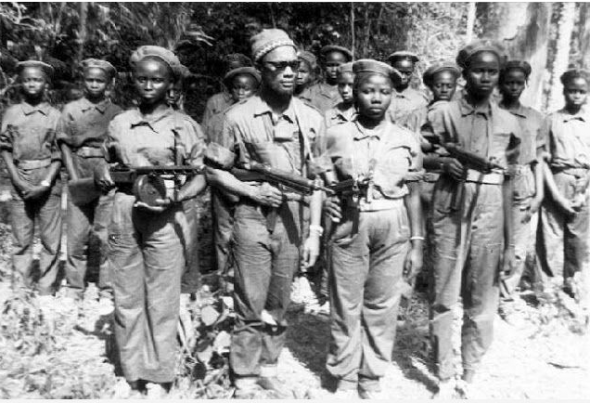
About a dozen teenage girls in camouflage, berets, and determined gazes stand in the black and white photograph. A few of them have large guns readied at their hips. In the center of the group stands Amilcar Cabral, who is 39 at the time.
It is February 1964—one year into the armed struggle for independence in Guinea Bissau against Portuguese colonial rule. Cabral, the independence struggle’s leader, had called a conference in Cassaca for his African Party for the Independence of Guinea and Cape Verde (PAIGC) fighters to re-organize and address inter-party grievances.
The Cabral as seen in this and similar photographs, with his defiant stance, dark glasses, and signature knitted stocking cap in spite of the West African heat, would become the iconic image of the West African country. More than fifty years later, the image is still used to signify both Guinea Bissau’s victory in the 11-year independence struggle and the country’s continued hopes for the future. But what about the faces of the young women surrounding the independence hero? Directly to Cabral’s left in the image stands a round-faced, then 14-year old girl, Joana Gomes.
Today, Joana is a member of Guinea Bissau’s parliament, as a representative from the post-independence PAIGC party. For the past few years, on my frequent trips to Bissau to record the stories of women who contributed to the liberation struggle, I always make sure to pay Joana a visit. Just a couple months after I met Joana in 2018, I brought up the black and white photo on my phone to ask if she knew any of the young women in the image. She burst out loudly in her hearty laugh and said, “My girl, of course I do. That is me!” and pointed to herself.
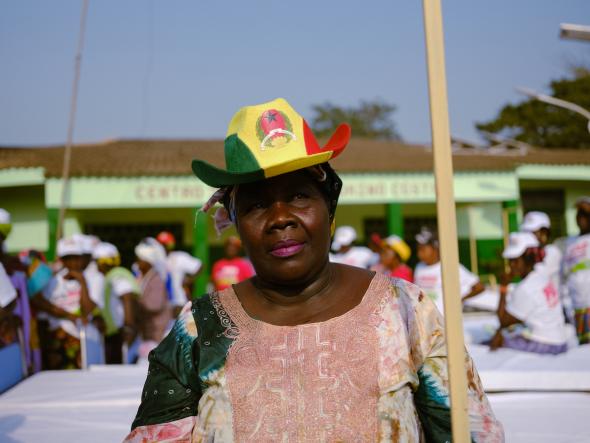 Fulacunda, Guinea Bissau (March 6, 2019) – Joana Gomes poses for a portait in front of the local hospital in Fulacunda, Guinea Bissau. Gomes, who was a medic on the frontlines during the independence war, donated beds to the hospital as part of her campaign. Image credit Ricci Shryock.
Fulacunda, Guinea Bissau (March 6, 2019) – Joana Gomes poses for a portait in front of the local hospital in Fulacunda, Guinea Bissau. Gomes, who was a medic on the frontlines during the independence war, donated beds to the hospital as part of her campaign. Image credit Ricci Shryock.
This visit, I want to ask Joana more about the moment that photo was taken. As I ride to her house in the hot backseat of a bright blue taxi, our car gets stuck in traffic. The hold-up is caused by a funeral procession snaking past the current headquarters of the PAIGC, which is still one of the largest political parties in the country. The taxi driver explains that an important member of the PAIGC and liberation fighter had died that week. I wonder why Joana is meeting me instead of attending the funeral.
Women like Joana and her sister, Teodora Gomes, a celebrated liberation fighter and a PAIGC leader, were crucial figures in the struggle for independence. Some of these women, such as Titina Silá and Carmen Pereira (both of whom have passed away), as well as living legends such as Francisa Pereira and Tedora, are remembered as individual heroes. But many of the women who fought during the liberation say the ideals of gender equality that they fought for did not materialize from the battle grounds into independent Guinea Bissau. The work that many of the women championed during the struggle, such as education and healthcare, were essential to winning the liberation fight, but today these services are not accessible to enough people in Guinea Bissau. Even the 2018 passage of a parity law requiring that 36 percent of members of parliament be women has so far not materialized into more formal representation. In the 2019 elections, only 14 of 102 elected members were women.
Today, many of the revolutionary fighters have passed away. But Joana and other women of the movement who are still living have important stories to tell about their contributions to the liberation effort, and their continued struggle to increase women’s political participation. They say their ideas can help bring increased equality to the country, which has had a history since independence of military coups and political instability.
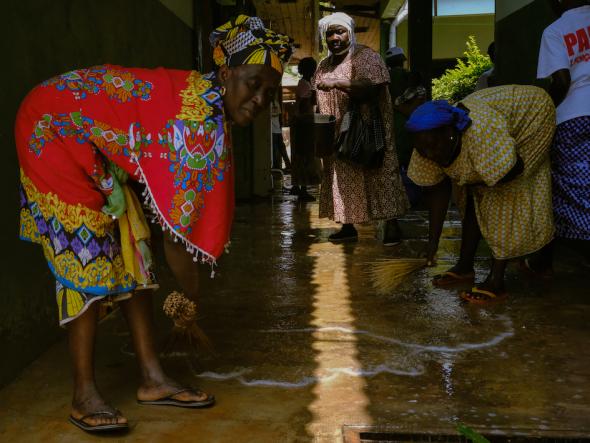 Fulacunda, Guinea Bissau (March 6, 2019) – Joana Gomes (center) instructs women cleaning the local hospital in Fulacunda, Guinea Bissau. Gomes, who was a medic on the frontlines during the independence war, donated beds to the hospital as part of her campaign. Image credit Ricci Shryock.
Fulacunda, Guinea Bissau (March 6, 2019) – Joana Gomes (center) instructs women cleaning the local hospital in Fulacunda, Guinea Bissau. Gomes, who was a medic on the frontlines during the independence war, donated beds to the hospital as part of her campaign. Image credit Ricci Shryock.
When our taxi finally makes it out of the traffic and we arrive at Joana’s house, it is mid-afternoon. Joana always (rightfully) insists on catching up on the present over food before diving into the past; today she has prepared a lunch of cafriella.
When we sit down, I show her again a digital copy of the photograph on my phone.
Joana then tells me about the long walk she had marched decades earlier, when she traveled from the rural camps near Can in the region of Quinara to Cassaca, in a liberated zone in the south of the country. The journey on foot took her at least a few days; she can’t remember exactly how many. She does recall marking her 14th birthday along the route, and a PAIGC soldier carrying her on his shoulders when she grew weary. Joana was marching for a pressing and painful reason: She wanted to confront Cabral about the death of her father, who had been shot and killed by a PAIGC soldier. She wanted to know if Cabral had indeed ordered her father’s death, as she had been told at the time, but she also admired the liberation leader and was thrilled to be in his presence.
“For the first time, I had the opportunity to be with our leader, Amílcar Cabral,” she said. “Imagine! I was very proud.”
Just before the photograph was taken, Joana recalls, she and the other girls were handed the army fatigues and guns to pose with. “It was hot,” she said of the weather. “At that moment it was the end of the Congress, imagine how many people were inside that bush.”
I ask what she was looking at, what we cannot see on the other side of the lens. “The future of Guinea-Bissau,” she said. “I don’t know if you understand. At that time we were young, with Cabral at our side; we didn’t know where we were going to go. We didn’t know what Guinea-Bissau was going to be like.”
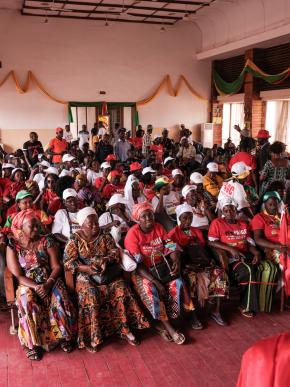 Bissau, Guinea Bissau (March 8, 2019) – Women from the PAIGC party in Guinea Bissau gather for an event on International Women’s Day, two days before legislative elections where a new law required that 36% of candidates be women. Image credit Ricci Shryock.In the vision he developed for the country, Cabral had made it clear that the fight for independence included the fight for women’s liberation from patriarchal oppression. He insisted that women hold two out of every five political positions in liberated zones; he worked to end child marriage, and increased access to education for girls.
Bissau, Guinea Bissau (March 8, 2019) – Women from the PAIGC party in Guinea Bissau gather for an event on International Women’s Day, two days before legislative elections where a new law required that 36% of candidates be women. Image credit Ricci Shryock.In the vision he developed for the country, Cabral had made it clear that the fight for independence included the fight for women’s liberation from patriarchal oppression. He insisted that women hold two out of every five political positions in liberated zones; he worked to end child marriage, and increased access to education for girls.
“Cabral was a genius,” Joana said. “Cabral admired women a lot. He wanted Guinean women to stand out, that’s why he gave us weapons, and he titled this photo as ‘Women Combatants.’ When you saw the photograph, you saw women as combatants, because of the rifles. Cabral wanted to show that in the national liberation struggle it was not only men, who took part, but also that there were female combatants who remained on the front lines.”
When this photo was taken, neither Joana nor her friends in the photograph had actually shot the guns before. In fact, moments after the photo was taken, she and the others would board a small boat that set off for neighboring Guinea-Conakry, where PAIGC had its headquarters during the liberation struggle, and where the girls would immediately begin their education in a classroom.
“When he gave you a rifle it was not to kill anyone, it was to go into combat,” she said. “And that was what we did during the fight, we went to study and went back to the bush on the front line, where we stayed until we gained independence.”
After attending a school set up by PAIGC fighters in Guinea Conakry, Joana went to study nursing in Kiev, in the then-Soviet Union. She then returned to the struggle as a medic on the front lines. “As a doctor myself, I gave medical assistance to war commanders,” she said. “On the front line, there are different ways of fighting.”
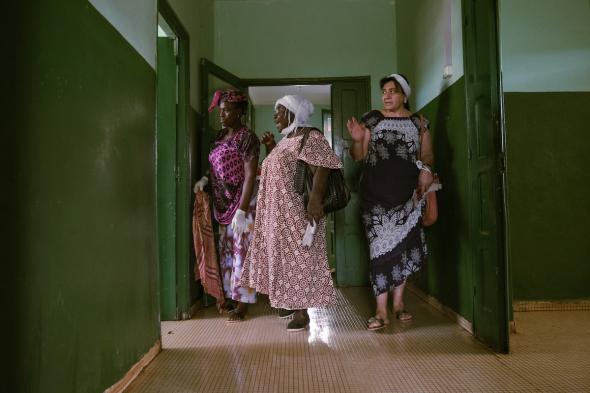 Fulacunda, Guinea Bissau (March 6, 2019) – Joana Gomes (center) instructs women cleaning the local hospital in Fulacunda, Guinea Bissau. Gomes, who was a medic on the frontlines during the independence war, donated beds to the hospital as part of her campaign. Image credit Ricci Shryock.
Fulacunda, Guinea Bissau (March 6, 2019) – Joana Gomes (center) instructs women cleaning the local hospital in Fulacunda, Guinea Bissau. Gomes, who was a medic on the frontlines during the independence war, donated beds to the hospital as part of her campaign. Image credit Ricci Shryock.
Her father, she added, would have been proud of the image of Joana in this photograph. Although her journey to Cassaca would result in her enlistment in the struggle, she did not forget the reason that brought her there.
After her father’s death, Joana said, people had told her that Cabral had ordered the killing. “That anguished me,” she said. “My father was killed unjustly. It revolted me because I knew who my father was, and the value of the person he was. So when I had the opportunity to go to the Congress, my concern was to see him [Cabral] and ask him why he had my father killed?”
For several days, Joana worked alongside Titina Sila, making coffee for Cabral and others as they held meetings during the congress. Eventually Joana got her one-on-one audience. Before she could ask her question, Cabral told her that he knew her father, and before Joana could tell Cabral her father had died, Cabral turned to a fellow fighter and said Joana’s father was the country’s “encyclopedia,” and would be very important after the war. “At that moment I started to realize the value of my father,” Joana told me. ”Because for Amílcar Cabral to say that my father was an encyclopedia…? I shut up until he finished. When he finished, I realized that he didn’t know that my father had been killed.”
Joana recalls breaking down crying as she interrogated a surprised Cabral about her father’s death. “I had wanted for a long time to be in front of the person who they said killed my father,” she told me. “While I was crying, he was crying too. We cried together. He took his glasses off, wiped his eyes and had to concentrate, because he wanted to know the truth. So Amílcar asked: How did he die? Osvaldo (a fellow fighter) told him that he had been murdered, Amílcar asked him: Murdered by whom? Osvaldo replied that it was José Sanha.”
At the time, Sahna was another PAIGC fighter, and in fact one reason Cabral had called the Conference at Cassaca was to address allegations of in-fighting in the PAIGC ranks. Cabral asked if Joana had the strength to accuse Sanha to his face, she says.
“I do,” she recalls telling him. “And if he didn’t do it, you will see that I will tremble. But I won’t tremble.” When Joana first accused him, Sanha had denied killing Joana’s father and said it was his deputy, but the deputy denied that version of the story.
According to Joana, after Cassaca, Sanha, along with others who had been accused of acts of atrocity, was taken into informal custody. He was sent to the northern front, but along the way to the military base they were attacked by Portuguese forces, and the PAIGC fighters freed Sanha and others to help them fight back the attackers. Cabral had said Sanha would face justice from “the Guinean people after liberation was won,” said Joana. “But when the war was finished, they had killed Cabral. And that’s how José Sanha was saved.”
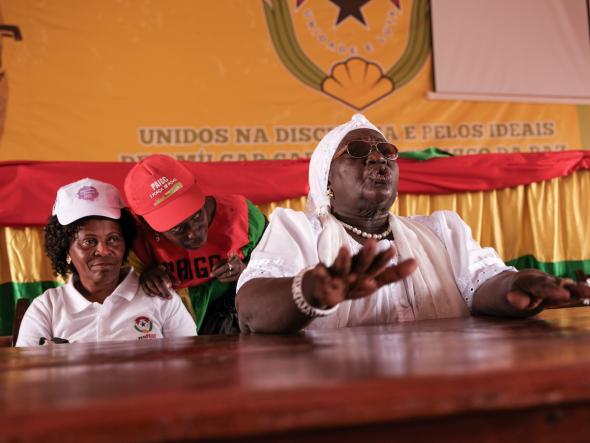 Bissau, Guinea Bissau (March 8, 2019) – Bilony Nhama (left, white shirt) is the Secretary General for the Women’s Democratic Union for the PAIGC party. She sits next to Teodora Gomes (far right), who is a hero of the country’s independence war. Here in Guinea Bissau, the women gather for an event on International Women’s Day, two days before legislative elections where a new law required that 36 % of candidates be women. Image credit Ricci Shryock.
Bissau, Guinea Bissau (March 8, 2019) – Bilony Nhama (left, white shirt) is the Secretary General for the Women’s Democratic Union for the PAIGC party. She sits next to Teodora Gomes (far right), who is a hero of the country’s independence war. Here in Guinea Bissau, the women gather for an event on International Women’s Day, two days before legislative elections where a new law required that 36 % of candidates be women. Image credit Ricci Shryock.
Post-liberation, Sanha became a high-ranking military official in Guinea Bissau. Sanha, along with others, were able to act with impunity in the country and often used their contribution to liberation as one reason they had the right to overthrow elected leaders. Guinea Bissau has witnessed at least 10 coups or attempted coups since 1974; historians differ on the exact number. In a small country such as Guinea Bissau, Joana along with other relatives of Sanha’s alleged victims, often found themselves at government events together. Joana remembers seeing Sanha at a ceremony at military headquarters, but refusing to greet him. “I saw him, but I stayed far away from him. I did not even go near where he was. He knew.”
Of course, it now makes sense why Joana had not attended that day’s funeral in Bissau. It was a procession for José Sanha.
Article originally published by Africa is a Country in 02.04.2021